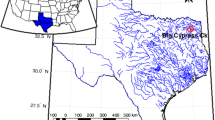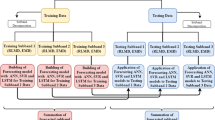Abstract
In this study, forecasting of stage and discharge was done in a time-series framework across three time horizons using three models: (i) persistence model, (ii) feed-forward neural network (FFNN) model, and (iii) support vector machine (SVM) model. For these models, lagged values of the time series constituted the set of input variables which had been selected by principal component analysis (PCA). Parameters of FFNN and SVM models were determined by sensitivity analysis. All the three models were evaluated using data from Mahanadi River, India, and their forecasting performance was then compared. It is shown that over a shorter forecasting horizon, it is difficult to outperform the persistence model. Moreover, results show that forecasting of stage and discharge over a longer time frame by the SVM model is more accurate than that by the other two models.


















Similar content being viewed by others
References
Abdel-Aal RE, Elhadidy MA, Shaahid SM (2009) Modeling and forecasting the mean hourly wind speed time series using GMDH-based abductive networks. Renew Energy 34:1686–1689
ASCE task committee on application of ANNs in Hydrology (2000) Artificial neural networks in hydrology, II: hydrologic applications. J Hydraul Eng ASCE 5(2):124–137
Bhattacharya B, Solomatine DP (2000) Application of artificial neural network in stage discharge relationship. Proceedings of 4th International Conference on Hydro informatics, Iowa, USA
Braca G (2008) Stage–discharge relationships in open channels: Practices and problems. FORALPS Technical Report, 11. Università degli Studi di Trento, Dipartimento di Ingegneria Civile e Ambientale, Trento, Italy, pp. 1-24
Cristianini N, Shawe-Taylor J (2000) Introduction to Support Vector Machines. Cambridge University Press
Eskandarinia A, Nazarpour H, Teimouri M, Ahmadi MZ (2010) Comparison of neural network and K nearest neighbour methods in daily flows forecasting. J Appl Sci 10(11):1006–1010
Gill MK, Tirusew A, Mariush WK, Mac M (2006) Soil moisture prediction using support vector machines. J Am Water Resour Assoc 42(4):1033–1046
Goel A, Pal M (2009) Application of support vector machines in scour prediction on grade-control structures. Eng Appl Artif Intel 22(2):216–223
Hippert HS, Pedreira CE, Souza RC (2001) Neural networks for short-term load forecasting: A review and evaluation. IEEE Trans Power Syst 16(1):44–55
Hsu KL, Gupta HV, Sorooshian S (1995) Artificial neural-network modeling of the rainfall-runoff process. Water Resour J 31(10):2517–2530
Jain SK, Chalisgaonkar D (2000) Setting up stage discharge relations using ANN. J Hydrolog Eng 5(4):428–433
Kecman V (2001) Learning and soft computing. The MIT Press
Khan MS, Coulibaly P (2006) Application of support vector machine in lake water level prediction. J Hydrolog Eng 11(3):199–205
Kisi O (2011) Wavelet regression model as an alternative to neural networks for river stage forecasting. Water Resour Manag 25:579–600
Minns AW, Hall MJ (1996) Artificial neural networks as rainfall-runoff models. Hydrolog Sci J 41(3):399–417
Mustafa MR, Rezaur RB, Saiedi S, Isa MH (2012) River suspended sediment prediction using various multilayer perceptron neural network training algorithms - A case study in Malaysia. Water Resour Manag 26(7):1879–1897
Pal M, Goel A (2007) Prediction of end-depth-ratio and discharge in Trapezoidal shaped channels using support vector machines. Water Resour Manag 21:1763–1780
Saini LM, Soni MK (2000) Artificial neural network based peak load forecasting using conjugate gradient methods. IEEE Trans Power Syst 17(3):907–912
Sainikhani H, Kisi O (2012) River flow estimation and forecasting by using two different adaptive neuro-fuzzy approaches. Water Resour Manag 26(12):1715–1729
Smith J, Eli RN (1995) Neural-network models of rainfall-runoff process. J Water Resour Plann Manag 121(6):499–508
Smola A, Scholkopf B (1998) A tutorial on support vector regression. Available: http://citeseer.ist.psu.edu/smola98tutorial.html
Srinivasulu S, Jain A (2009) River flow prediction using an integrated approach. J Hydrolog Eng ASCE 14(1):75–83
Sudheer KP, Jain SK (2003) Radial basis function neural network for modelling rating curves. J Hydrolog Eng 8(3):161–164
Tawfik M, Ibrahim A, Fahmy H (1997) Hysteresis sensitive neural network for modeling rating curves. J Comput Civ Eng 11(3):206–211
Tokar AS, Markus M (2000) Precipitation-runoff modeling using artificial neural networks and conceptual models. J Hydrolog Eng 5(2):156–161
Vapnik VN (1995) The nature of statistical learning theory. Springer, New York
Yonaba H, Anctil F, Fortin V (2010) Comparing sigmoid transfer functions of neural network multistep ahead stream forecasting. J Hydrolog Eng ASCE 15(4):275–283
Yu P-S, Shien TC, Fan IC (2006) Support vector regression for real time flood stage forecasting. J Hydrol 328:704–716
Acknowledgments
Authors are thankful to the Chief Engineer, Eastern Gauging Division, Bhuwneshwar (Orissa State), Central Water Commission, Ministry of Water Resources (Government of India) for providing stage-discharge data, without which it would not have possible to complete the present study.
Author information
Authors and Affiliations
Corresponding author
Rights and permissions
About this article
Cite this article
Aggarwal, S.K., Goel, A. & Singh, V.P. Stage and Discharge Forecasting by SVM and ANN Techniques. Water Resour Manage 26, 3705–3724 (2012). https://doi.org/10.1007/s11269-012-0098-x
Received:
Accepted:
Published:
Issue Date:
DOI: https://doi.org/10.1007/s11269-012-0098-x




